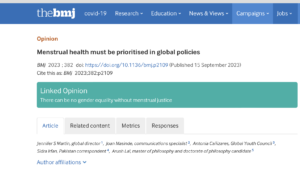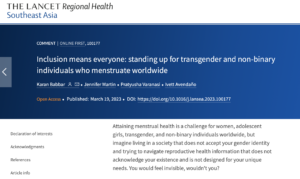Disclaimer: for ease of language, women are referred to as all child-bearing people
Coined in 1994 by the Women of African Descent for Reproductive Justice, reproductive justice [1] refers to women’s inherent right to maintain bodily autonomy and decide freely and responsibly over matters related to their reproductivity, namely the right to have children or not to have children, and the right to parent children in safe and healthy environments. Foundational to gender equality, reproductive justice takes an expansive and holistic gaze to address and understand the systemic and political conditions where women’s choices over their bodily autonomy are made, respected, and fulfilled.
For so long, government and patriarchy controlled, coerced, and policed these choices [2], leading to a well-conditioned state of reproductive surveillance and institutionalised misogyny. In the “Big Tech” [3] age, reproductive justice has become a rampant digital rights issue. And here is why:
1.Data oligarchs are impinging on reproductive privacy
Health data is highly sensitive private information. Yet, it is still regarded as an outstanding case in data governance[4] because it requires legislation that is specific to the health sector, thus leading to a fragmented regulatory framework where health data is shared, sold, and interfered with by commercials and government alike. As health data apps have become ubiquitous and even strongly encouraged to harness the advent of telemedicine and virtual access to health services, a massive data broker industry surged using secret algorithms that can easily profile user’s health status and undermine their decisional and reproductive privacy [5].
2. The uptake of digital health technology is not addressing gender digital divides
The global Covid-19 crisis taught the world how to overcome disruptions in healthcare services caused by mobility restrictions which led to the accelerated uptake of digital health technology and related interventions. Little the world knew this shift needed to happen within an environment that is concerned with the existing and widespread inequality in access, use and engagement with digital technologies [6] whereby women are excluded mainly and put at further risk of exposure to harmful practices such as overriding consent, privacy violations, online gender-based violence. The development of digital health technology is not a stand-alone process; for that, it must take shape and meaning in a context that addresses the barriers preventing two billion women [7] from the digital revolution.
3. The digital surveillance of abortion-seekers is a state watchdog in the making
The digital surveillance of vulnerable groups, including abortion seekers, is no old news; however, the implications are more harrowing considering the use of forensic tools by police and non-state actors that can efficiently turn medical staff and pregnant providers into criminal investigators without prior consent [8]. The Surveillance Technology Oversight Project released a white paper that corroborates cases where law enforcement workers used geofence to obtain search histories from pregnant women’s devices without a warrant. The police and prosecutors used the records to charge potential abortion seekers with second-degree murder following a miscarriage. In a post-Roe era, the deployment of digital surveillance techniques to track and cast queries about miscarriages, including benign medical questions, can eventually lead to an arrest through deliberate tactics to harass pregnant women and chill their exercise of reproductive rights.
4. Innovation is way ahead the reproductive justice movement
While the tech motto “move fast and break things” [9] is driving innovative solutions at an unprecedented pace, the reproductive justice movement (a.k.a; networks and constituencies working on broader sexual reproductive health and rights (SRHR)) is slowly getting the hang of tech savviness. Moving fast often comes at the compromised cost of ethics and safety, which contradicts the “do-no-harm” guiding principle of reproductive justice. For both parties to find common ground, it is essential to acknowledge the power dynamics that are playing out. The innovation hubris cannot keep on assuming it knows best; it must carefully start listening to survivors and users to understand and respond to their needs.
5. The apparatus of reproductive ad censorship is sprawling on social media platforms
In October 2022, META amended its sexual health advertising policies to include ads that promote sexual health, wellness and reproductive products and services, ensuring the Center for Intimacy Justice (CIJ)’s investigative report and advocacy to change META’s systemic rejections of women’s health advertisements[10]. Among others, the report shed light on cases where META allowed health ads about male pleasure when it systematically rejected ads on products addressing the effects of menopause or pain relief during sex. The apparatus of reproductive ad censorship is not happening in a vacuum; it is sprawling in a setting of gender-biased, sexualised and out-of-context algorithmic processes, moderation training and overall content governance.
In a digital age, reproductive justice can only amplify opportunities for women to reclaim their bodily autonomy. It offers an opportunity to address intimidation, suppression, and surveillance both offline and online, but it is crucial that women’s reproductive rights are preserved online.
Our bodies, our choices!
Written by: Marwa Azelmat, digital rights expert at RNW Media and feminist activist exploring the impact of technology on social justice from an intersectional lens.
[1] https://www.leaf.ca/issue-area/reproductive-justice/#:~:text=Reproductive%20justice%2C%20a%20term%20coined,access%20to%20reproductive%20health%20services.
[2] https://www.law.georgetown.edu/privacy-technology-center/events/the-color-of-surveillance-policing-of-abortion-and-reproduction/
[3] Big Tech, also known as the Tech Giants, refers to the most dominant companies in the Information and Communications Technology (ICT) industry
[4] https://tehdas.eu/app/uploads/2021/06/tehdas-why-health-is-a-special-case-for-data-governance-2021-06-23.pdf
[5] https://epic.org/reproductive-privacy-in-the-age-of-surveillance-capitalism/
[6] https://www.who.int/europe/publications/i/item/WHO-EURO-2022-6810-46576-67595
[7] https://www.itu.int/itu-d/reports/statistics/2022/11/24/ff22-the-gender-digital-divide/
[8] https://www.stopspying.org/pregnancy-panopticon
[9] https://www.unfpa.org/sites/default/files/pub-pdf/UNFPA_SafeEthicalGBVTechGuide_Summary_2023.pdf[10] https://www.intimacyjustice.org/meta








